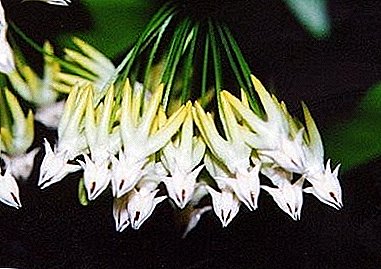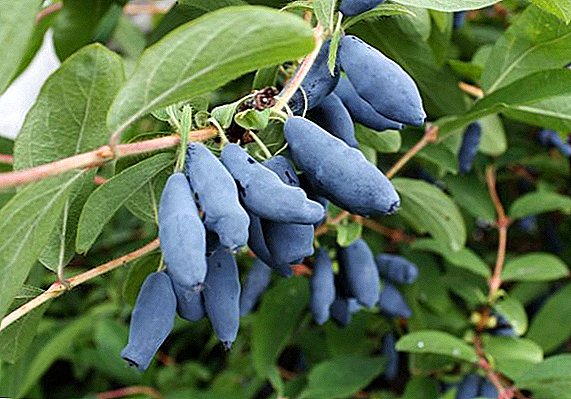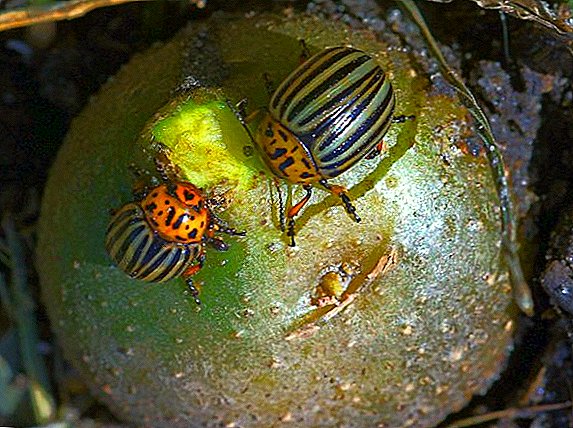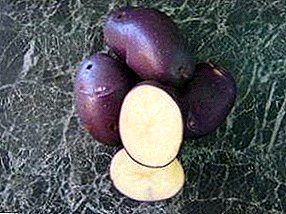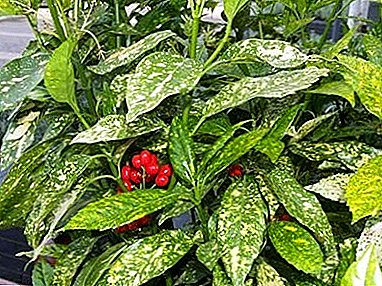
Aukuba - a popular plant grown in indoor and garden conditions.
It is distinguished by its simplicity in its content and the special decorative effect of the leaves, which are covered with bright golden spots.
Description
 The peculiarity of this plant is a beautiful crown of green color, covered with golden specks. This coloring and allowed to give the flower the name "golden tree".
The peculiarity of this plant is a beautiful crown of green color, covered with golden specks. This coloring and allowed to give the flower the name "golden tree".
According to another version, the coloring resembles a sausage cut, therefore it is also called the “sausage tree”.
Under natural conditions, this shrub forms an underbrush in the subtropics. It occurs in the Himalayas, Korea. His homeland is Japan.
Translated from the Japanese, "aukuba" is a "green plant." In nature, it is a shrub up to five meters. Its leathery leaves are elongated in shape on short stalks. Along the edges of the sheet plate is covered with notches.
Aukuba at home blooms rarely. During flowering, small inflorescences of bright red tone appear on the tips of the shoots. Bush with green leaves, covered with bright yellow spots and decorated with small flowers looks very elegant. And after flowering, it still forms berries, like dogwood. But this happens only if there is both a male and a female tree in your collection. Aukuba is a dioecious plant, and bears fruit only after fertilization by an individual of the opposite sex.
Kinds
 Compared with other plants, aucuba are few in number. But modern breeders bred varieties that differ in the color of foliage.
Compared with other plants, aucuba are few in number. But modern breeders bred varieties that differ in the color of foliage.
On some spots only the center of the leaf is covered, while others are covered with a scattering of small specks.
There are even species in which the greens make their way only to the very edge, and the whole plate is golden.
The most famous and often found in the room floriculture are two types:
Japanese
In nature, it grows in Japan and Korea. Forms of this type differ in location and size of spots. It has oval leaves with a smooth surface. The length of the leaves reaches 20 centimeters. Plant height under favorable conditions reaches two meters. The flowers of the plant are bright, rich red, gathered in fluffy panicles. Fruiting occurs rarely. The berries on it can form not only red, but yellow and white. A beautiful crown of this type can only be formed with regular pruning. This is the most common type. Admire the plants of this species can be in the photo below.


Himalayan
This species comes from the Eastern Himalayas. In home growing is much less common. It differs from the Japanese thin, sharp leaves of dark green color. Rugged edges. Forms fast-growing shoots that require timely pruning. Photos of Aucuba Himalayan are available below.


Is aukuba dangerous at home?
Aukuba - a poisonous flower, therefore, it is not recommended to keep it in a house where there are children or pets. The poison is found in all parts of the plant!
ATTENTION. It is forbidden to grow aukubu in children's institutions!
Aukuba in the garden
 In the open ground "golden tree" can grow in the Black Sea coast. This evergreen shrub grows to five meters. Forms a lush, heavily leafy form. Hardy to environmental conditions. Grown on slightly acid soils. It can grow in sunny and shaded places.
In the open ground "golden tree" can grow in the Black Sea coast. This evergreen shrub grows to five meters. Forms a lush, heavily leafy form. Hardy to environmental conditions. Grown on slightly acid soils. It can grow in sunny and shaded places.
Home care
Japanese aukuba or golden tree (flower) - unpretentious planting. It can survive even in unsuitable conditions for other indoor colors. Does not react to temperature changes, dirty air, normally feels in a dark place.
To preserve the maximum decorativeness of aucuba, you need to follow some rules on its content.
After the purchase
As with any plant, it is recommended that aucubu should be transplanted from a shipping container into a more suitable container after purchase. Transplantation is carried out by the method of transshipment, so as not to tear the delicate roots. Immediately do not water the plant, do it on the second day.
Where to grow?
 Aukuba loves an average temperature of between 22-23 degrees. He does not like sudden changes in temperature, he reacts to them with a sharp yellowing of the leaves. The plant at the same time loses its decorativeness, acquires a pale, unkempt form.
Aukuba loves an average temperature of between 22-23 degrees. He does not like sudden changes in temperature, he reacts to them with a sharp yellowing of the leaves. The plant at the same time loses its decorativeness, acquires a pale, unkempt form.
In winter, the plants need to pick a cool place. But the temperature should not fall below six degrees.
From the light depends on the color of the leaves. Aucuba will grow in the shade and in the sun, but in a well-lit place the color of the leaves acquires a rich golden hue, and the number and size of the spots increase. Only the light should not be direct, otherwise the leaves turn pale. Ideal for aucuba would be windows facing east or west. You can put it next to the southern windows, but at some distance.
TIP. In the summer, place the plant on a ventilated balcony, where it will feel great. Just protect the flower from drafts and strong winds.
Planting and Transplant Rules
 Unlike other plants, aucuba does not require frequent transplantation. In one capacity, it perfectly exists up to 10 years. Consider this when planting a plant from the age of three. The pot immediately need to pick a big one. At the bottom lay a layer of drainage. The soil is prepared from a mixture of sand, peat and earth. All components in equal parts.
Unlike other plants, aucuba does not require frequent transplantation. In one capacity, it perfectly exists up to 10 years. Consider this when planting a plant from the age of three. The pot immediately need to pick a big one. At the bottom lay a layer of drainage. The soil is prepared from a mixture of sand, peat and earth. All components in equal parts.
Young specimens in the period of active growth are transplanted once a year. In adults, partial replacement of the soil is possible (approximately one third of the upper part).
But in this question the opinion of experienced flower growers is contradictory. Some argue that if the plant is not replanted once every 4-5 years, then the characteristic golden spots will start to disappear, the plant will lose its attractive coloring feature.
An adult copy is transferred to a new pot with care. This should be done with signs of filling the container with roots. If the individual roots began to break through to the surface, it's time to act.
How to water?
Watering should be uniform. Do not allow strong drying of earthen coma. At the same time, overmoistening is harmful. Humidity of the air is ideally needed high, but it is not afraid of short-term dryness.
During the heating season, when the air is dry, aukubu should be regularly sprayed. During this period, you can use a humidifier or use decorative fountains.
Feeding rules
 Aukuba feeding during the vegetative period is carried out once a week, combining with irrigation. Fertilizer for leaf flowers is universally suitable for top dressing. Use recommended concentration on the package.
Aukuba feeding during the vegetative period is carried out once a week, combining with irrigation. Fertilizer for leaf flowers is universally suitable for top dressing. Use recommended concentration on the package.
The plant responds well to organic fertilizers. They can be used as a solution every other week.
Breeding methods
- The handle.
- Sowing seeds.
Held in February-March. Take a stalk with two or three leaves. Separated from the stem and placed in a wet peat-sand mixture. In the absence of peat, you can only use sand.
As soon as the cutting gives the roots, small leaves appear on it. Before they appear, the pot should be covered with a bag, plastic or glass cap. The rooted sprout is planted in a separate container into the soil from the ground, sand and peat. You can add a bit of humus or turf to the mixture, as well as crushed charcoal.
In the first two - three years, the young sprout is transplanted into new pots. The matured plant is planted in a permanent place in a large tank.
The method is less popular due to the fact that the plant from the seed grows very slowly. In addition, when it is a new plant is not transmitted characteristic diversity of leaves. Therefore, variegated seed variety is not recommended.
 It is possible to get seeds at home only if there are two heterosexual specimens, otherwise germs of seeds will not form during flowering.
It is possible to get seeds at home only if there are two heterosexual specimens, otherwise germs of seeds will not form during flowering.
If you bought aucuba seeds and decided to sow them, soak them first for a few hours. Then sow in a wide flat dish, sprinkle and cover with glass to create greenhouse conditions. So that the seeds do not overheat. Do not hold crockery on a sunny window.
Pruning
Aukuba requires constant crown formation. In order to achieve the density and beautiful shape of the aerial parts shoots are recommended to be cut.
In young specimens, pinching of the tops of the shoots is carried out, the plants at the same time giving new sprouts and forking, actively increasing the leaf mass.
Learn about the features of cultivation can also be from the video:
What is sick aukuba?
With improper watering, the plant can be affected by rot. This is due to overmoistening of the soil and too cold content.
Root rot stains the root system in a brown-red color, the plant's nutrition stops and it dies at high speed. It is often affected by young, fragile specimens. Prevention - the right care, compliance with temperature and watering regimes. If the plant is sick, it can be saved, but only in the initial stages. A severely affected instance will die for sure.
Remove the plant from the pot, rinse the roots and cut the affected areas. Change the pot and soil. After transplanting water a little.
Pests
 Like all leafy species, aukuba is most often affected by a shield and aphids. These pests settle first on the underside of the leaves. And then cover the entire surface. Leaves from which insects suck up all juice. They become lethargic. Aphid additionally covers them with a sticky coating.
Like all leafy species, aukuba is most often affected by a shield and aphids. These pests settle first on the underside of the leaves. And then cover the entire surface. Leaves from which insects suck up all juice. They become lethargic. Aphid additionally covers them with a sticky coating.
Having noticed signs of pests on the plant (black or brown specks), treat the foliage with a solution of soap. Then spray it with insecticide. Processing should be repeated three times, with an interval of 14 days.
Shchitovku destroy so may not succeed. Clean it with a swab moistened with alcohol solution.
If a white bloom appears on the leaves, it means that the aucuba is affected by a spider mite. The plant must be washed and treated with poison.
The appearance of bleached spots - a signal of infection with thrips, settled on the underside of the sheet. Insect spreads at high speed. And its appearance contributes to increased temperature and low humidity. Control measures include treatment with Inta-Vir, Actellic, Decis.
What is useful aukuba?
The leaves of the plant contain active substances that destroy harmful bacteria from the air. This is how the air microflora of the room is regulated.
The psychological properties of this plant are also known. It can create an atmosphere of calm and cohesion. But boasters it makes listening to others, and it becomes easier to communicate with him. Aukuba protects your home from negative energy brought by other people. There is also a belief that no one can offend the owner of a well-kept plant, it is a kind of talisman for him.
Aucuba leaves are filled with surface-active substances that help the recovery of body tissues. With injuries and burns, leaves can be applied to the skin, as they have an anti-inflammatory effect. Also aukuba help with frostbite, bruising. For these purposes, shredded leaves of the plant are used.
Danger of use
 Use aukubu cautiously. It may cause local irritation in case of increased sensitivity of the skin, so it is advisable to consult with a doctor first.
Use aukubu cautiously. It may cause local irritation in case of increased sensitivity of the skin, so it is advisable to consult with a doctor first.
Growing difficulties
Inexperienced care growers face certain problems:
- The fragility of the leaves indicates a lack of water.
- Shallow leaves are caused by a lack of nutrients.
- The appearance of brown drying specks on the leaves indicates that the plant is burned by the sun.
- Falling foliage comes from too dry air content.
Aukuba Frequent problem - leaves turn black, what to do?
The cause of this phenomenon is excessive soil moisture. Aukuba - a plant that is better not to pour than pour. It tolerates temporary drying of the soil easily, and blackens from moisture. Therefore, if you notice blackening of the tips, reduce watering, otherwise the foliage will turn black and fall off, the plant will die.
Blackness can also be associated with improper wintering, when the air from the batteries is too dry and the temperature is too high.
Watch aukuba and change conditions of detention depending on signs of trouble.
Minimal care and maximum decorativeness - this is the attractiveness of growing this plant. Its unusual, as if the foliage specially painted with bright colors will decorate the interior of the apartment and planting in the country.


